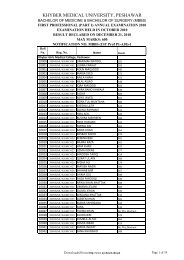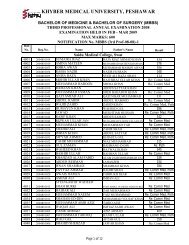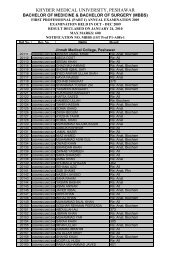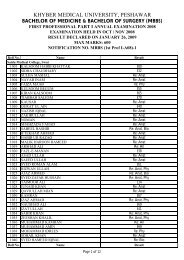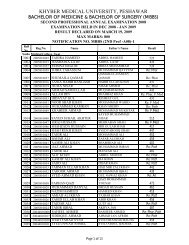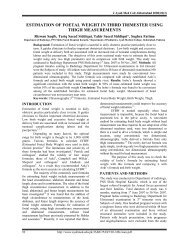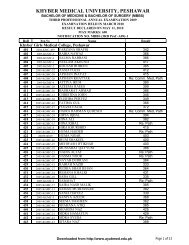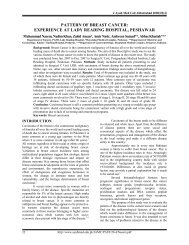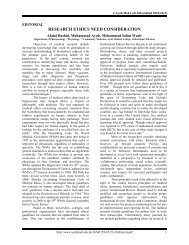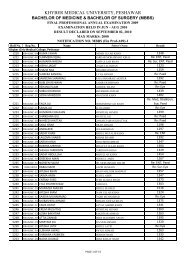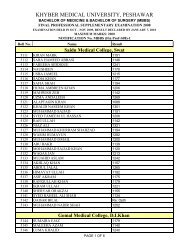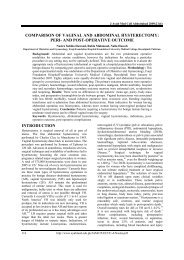alkaline phosphatase as a screening test for osteomalacia
alkaline phosphatase as a screening test for osteomalacia
alkaline phosphatase as a screening test for osteomalacia
You also want an ePaper? Increase the reach of your titles
YUMPU automatically turns print PDFs into web optimized ePapers that Google loves.
J Ayub Med Coll Abbottabad 2011;23(1)<br />
ORIGINAL ARTICLE<br />
ALKALINE PHOSPHATASE AS A SCREENING TEST FOR<br />
OSTEOMALACIA<br />
Muhammad Amin Chinoy, Muhammad Imran Javed*, Alamzeb Khan**,<br />
Nooruddin Sadruddin***<br />
Department of Trauma and Orthopaedics, The Indus Hospital, *Baqi Medical University, Karachi,<br />
**Ayub Medical College, Abbottabad, ***Imam Clinic, Karachi, Pakistan<br />
Background: Vitamin D deficiency remains common in children and adults in Pakistan despite<br />
adequate sunlight exposure. Diagnosis in adults is usually delayed and is made following pathological<br />
fractures that result in significant morbidity. The objective of this study w<strong>as</strong> to see whether Serum<br />
Alkaline Phosphat<strong>as</strong>e levels could be used <strong>as</strong> a <strong>screening</strong> <strong>test</strong> <strong>for</strong> <strong>osteomalacia</strong>. Methods: The Study<br />
w<strong>as</strong> conducted at Fatima Hospital, Baqai Medical University, Gadap, Karachi, between July 2002 and<br />
June 2005. Serum calcium levels are commonly used to screen patients suspected of <strong>osteomalacia</strong>, and<br />
raised serum <strong>alkaline</strong> <strong>phosphat<strong>as</strong>e</strong> (SALP) is considered a diagnostic finding. We used SALP to screen<br />
patients who presented with back or non-specific aches and pain of more than six months duration.<br />
Results: Three hundred thirty-four (334) patients were screened of which 116 (35%) had raised SALP.<br />
Osteomalacia w<strong>as</strong> diagnosed in 92 (79.3%) of these 116 either by plain radiographs, bone biopsy or<br />
isotope bone scan. Fifty-four (53.4%) of the 101 c<strong>as</strong>es had a normal level of serum calcium.<br />
Conclusions: Osteomalacia is likely to be missed if only serum calcium is used to screen patients.<br />
Serum Alkaline Phosphate should be used <strong>as</strong> the preferred method <strong>for</strong> <strong>screening</strong> these patients.<br />
Keywords: Osteomalacia, Metabolic bone dise<strong>as</strong>e, Serum Alkaline Phosphat<strong>as</strong>e (SALP), Screening<br />
INTRODUCTION<br />
Osteomalacia (a deficiency of vitamin D or its active<br />
metabolite 1,25 Hydroxy Vitamin D 3 in serum) is a<br />
common disorder seen in orthopaedic and rheumatology<br />
practices in South E<strong>as</strong>t Asian region, despite adequate<br />
sunshine. 1,2 Vitamin D deficiency and the secondary<br />
incre<strong>as</strong>e in parathyroid hormone levels result in<br />
inadequate mineralization of the osteoid seam. The<br />
diagnosis is often delayed, with the majority of patients<br />
diagnosed when they present with Looser’s zones or<br />
pathological fractures. The diagnosis of <strong>osteomalacia</strong><br />
should be b<strong>as</strong>ed on a combination of serum levels of<br />
calcium, <strong>alkaline</strong> <strong>phosphat<strong>as</strong>e</strong>, vitamin D and<br />
parathyroid hormone, along with radiological evidence<br />
of Looser’s zone or pathological fractures.<br />
Most of these patients present with a<br />
combination of symptoms including muscular pain, and<br />
chest pain, lower back pain and difficulty in getting up<br />
and walking. In extreme c<strong>as</strong>es, patients develop a<br />
waddling gait. Female patients are frequently anaemic<br />
with a history of multiple pregnancies. Many patients<br />
live in over-crowded homes that are typically in<br />
buildings with no access to fresh air or sunlight. If<br />
vitamin D deficiency is suspected in a general physician<br />
practice, usually only a serum calcium level is checked.<br />
With b<strong>as</strong>ic knowledge of physiology, it is quite clear that<br />
levels of serum calcium will either be normal or in the<br />
lower range of normal in patients with <strong>osteomalacia</strong>, and<br />
these patients will be missed if only serum calcium is<br />
used to screen patients.<br />
The vitamin D <strong>as</strong>say though specific and<br />
diagnostic, is expensive and not universally available <strong>as</strong><br />
is the serum parathyroid <strong>test</strong>. These are appropriately<br />
considered diagnostic <strong>test</strong>s but are not appropriate <strong>for</strong><br />
<strong>screening</strong> purposes. There is ambiguity about the role of<br />
Serum Alkaline Phosphat<strong>as</strong>e (SALP) levels and their<br />
specificity and sensitivity in the diagnosis of<br />
<strong>osteomalacia</strong>. SALP may be raised in other disorders of<br />
bone metabolism <strong>as</strong> well <strong>as</strong> in dise<strong>as</strong>es of the liver and<br />
biliary tree. This study w<strong>as</strong> done to determine the<br />
suitability of SALP <strong>as</strong> a <strong>screening</strong> tool <strong>for</strong> <strong>osteomalacia</strong>.<br />
MATERIAL AND METHODS<br />
This w<strong>as</strong> a prospective study carried out between July<br />
2002 and June 2005 at Fatima Hospital, Baqai Medical<br />
University. We enrolled females 14 years of age or<br />
above presenting with back pain 3 or muscular aches and<br />
pains of six months or greater duration <strong>as</strong> well <strong>as</strong> those<br />
with multiple pregnancies with the same<br />
symptomatology, who were clinically suspected of<br />
<strong>osteomalacia</strong>. Serum Calcium levels and Serum Alkaline<br />
Phosphat<strong>as</strong>e levels were done <strong>as</strong> well <strong>as</strong> SGPT and<br />
Gamma GT to rule out any Hepatobiliary cause.<br />
Radiographs of the pelvis (anterior-posterior view) were<br />
also obtained. They are essential <strong>for</strong> proper diagnosis and<br />
we prospectively looked into it at the same time to<br />
evaluate if SALP w<strong>as</strong> useful <strong>as</strong> a <strong>screening</strong> tool or not, in<br />
addition to its established role <strong>as</strong> a diagnostic modality<br />
All patients were seen by one of the authors<br />
and enrolled in the study. Patients who had proven<br />
Connective tissue disorders (Including RA, SLE and<br />
Ankylosing Spondylitis), patients with Hepato-biliary<br />
disorders or those with Hypertension and on medicines<br />
were excluded from the study.<br />
http://www.ayubmed.edu.pk/JAMC/23-1/Chinoy.pdf 23
J Ayub Med Coll Abbottabad 2011;23(1)<br />
Patients who had raised levels of SALP with<br />
normal radiographs and normal LFTs were offered<br />
trephine bone biopsy 4 from the posterior iliac crest under<br />
local anaesthesia which w<strong>as</strong> done by one of the authors.<br />
Patients who refused bone biopsies were offered an<br />
isotope bone scan. 5 This w<strong>as</strong> done at the Karachi<br />
Institute of Radiotherapy and Nuclear Medicine<br />
(KIRAN). They were given 2 doses of injectable vitamin<br />
D 3 , to see if there w<strong>as</strong> an improvement in their<br />
symptoms, if they refused to have Isotope Bone Scan <strong>as</strong><br />
well. Data w<strong>as</strong> analysed using SPSS-10.<br />
RESULTS<br />
From July 1999 to June 2002, SALP w<strong>as</strong> checked in 334<br />
female patients. One hundred and sixteen (35%) patients<br />
had raised SALP levels. The age distribution of the<br />
patients w<strong>as</strong> 14 to 60 years, with mean of 24 years.<br />
Duration of the <strong>osteomalacia</strong> symptoms ranged from 24<br />
weeks to 312 weeks (6 years), with a mean of 87 weeks.<br />
Of the 116 patients with raised SALP levels, 71<br />
(61%) had radiographic evidence of Looser’s zone or<br />
pathological fracture. Remaining 45 (39%) patients who<br />
did not have any radiological evidence of <strong>osteomalacia</strong>,<br />
bone biopsy from the posterior iliac crest w<strong>as</strong> done in 18<br />
and isotope bone scan w<strong>as</strong> done in 8 patients. The<br />
remaining 19 patients who refused all sorts of<br />
investigations were given 2 doses of injection Vitamin<br />
D 3 , 600,000 IU.<br />
Fifteen bone biopsies and 5 Isotope bone scans<br />
were positive <strong>for</strong> <strong>osteomalacia</strong>. Among those who were<br />
given Vitamin D 3 injections, 10 patients had marked<br />
improvement in their symptoms, 1 patient did not show<br />
any improvement in their symptoms, and 8 were lost to<br />
follow up. Serum Calcium w<strong>as</strong> found to be normal in 54<br />
(53.4%) in which a confirmed diagnosis of <strong>osteomalacia</strong><br />
w<strong>as</strong> made.<br />
The Positive Predictive value of a raised Serum<br />
Alkaline Phosphat<strong>as</strong>e level w<strong>as</strong> 97.5%. One patient who<br />
had a negative bone scan, but with a very high level of<br />
SALP (over 9 times the normal), a subsequent biopsy<br />
confirmed <strong>osteomalacia</strong>. Five patients with radiological<br />
evidence of <strong>osteomalacia</strong> had normal or upper limit of<br />
normal level of <strong>alkaline</strong> <strong>phosphat<strong>as</strong>e</strong>. There were only 5<br />
false negative results, giving a negative predictive value<br />
of 4.31% <strong>for</strong> this investigation.<br />
DISCUSSION<br />
Osteomalacia is a common disorder found in our<br />
community. This is despite the fact that we have<br />
adequate amount of sunlight, and hence its occurrence<br />
should be minimum. However various studies from<br />
countries such <strong>as</strong> India, Saudi Arabia 6 , Kuwait 7 and<br />
Turkey 8 have shown that even in those countries with<br />
similar climatic conditions, <strong>osteomalacia</strong> seems to be<br />
quite common. In some of these studies, the cultural and<br />
clothing patterns 9 <strong>as</strong> well <strong>as</strong> the use of veil have been<br />
implicated in the causation of <strong>osteomalacia</strong>. Similarly, it<br />
is common among the Immigrant population from<br />
countries of South-E<strong>as</strong>t Asia to countries like UK 10 and<br />
Norway and Denmark.<br />
This is especially common in females of child<br />
bearing age. 11,12 Previous studies have documented its<br />
occurrence in females, who have repeated pregnancies,<br />
and those who are living in crowded and congested are<strong>as</strong>,<br />
in multi story buildings with very little exposure to<br />
sunlight. Various studies have looked into the amount of<br />
body surface area exposed to sunlight, its variants<br />
Ultraviolet B and its relationship to skin pigmentation. 13<br />
Turnbull 14 and colleagues showed that pre-Vitamin D 3<br />
effective UV wavelengths in the shade were most<br />
significant <strong>for</strong> tree shade and a shade umbrella, and they<br />
also studied conditions of shades in a north facing<br />
covered veranda and in a car with windows closed.<br />
Studies have also looked into the role of betel and betel<br />
nuts <strong>as</strong> well <strong>as</strong> the amount of lime on the betel leaves and<br />
their subsequent role in <strong>osteomalacia</strong> and osteoporosis by<br />
inactivation of 25 hydroxyl<strong>as</strong>e. 15 Through standard<br />
<strong>for</strong>tification of various food stuffs including milk and its<br />
products and margarine, <strong>osteomalacia</strong> h<strong>as</strong> largely been<br />
eradicated in developed countries. Ghee and oils are the<br />
only foods <strong>for</strong>tified with vitamin D in Pakistan and their<br />
<strong>for</strong>tification level may not be sufficient to fulfil the<br />
vitamin D requirement of the population. All these play<br />
an important part <strong>as</strong> causative agents in the pathogenesis<br />
of <strong>osteomalacia</strong> and its rampant occurrence in our<br />
society.<br />
Un<strong>for</strong>tunately, despite its very common<br />
occurrence, diagnosis is often delayed. This is usually<br />
due to poor socioeconomic factors initially, when<br />
patients present quite late to a physician. These are<br />
usually young to middle aged females who have to look<br />
after the household, do the cleaning and w<strong>as</strong>hing, home<br />
shopping, caring <strong>for</strong> the many children that each of them<br />
have, <strong>as</strong> well <strong>as</strong> caring <strong>for</strong> the aged in the family.<br />
Sometimes they are also working <strong>as</strong> housemaids in<br />
addition to their other duties, which leave them with very<br />
little time to look after themselves or to seek medical<br />
advice at an early stage.<br />
When they do finally seek medical advice,<br />
initially most of them are treated symptomatically. If any<br />
investigation is ordered, it is the Serum Calcium Level,<br />
which we have shown in our study to be Normal or low<br />
normal in most of the patients. Thus an early diagnostic<br />
window is missed, and these patients continue with their<br />
aches and pains and muscle weaknesses until they<br />
develop pathological fractures and a waddling gait. This<br />
hypovitaminosis D myopathy h<strong>as</strong> also been shown in the<br />
Danish study comparing veiled Arab women with<br />
Danish controls. 16 Most subjects present at this stage<br />
with waddling gait. The radiographs become positive at<br />
this stage (Looser’s zone), though spontaneous bilateral<br />
displaced femoral neck fractures have also been<br />
24<br />
http://www.ayubmed.edu.pk/JAMC/23-1/Chinoy.pdf
J Ayub Med Coll Abbottabad 2011;23(1)<br />
reported. 17 At this stage, biochemical changes are now<br />
established. 18<br />
In this study, we evaluated the role of SALP <strong>as</strong><br />
a <strong>screening</strong> marker <strong>for</strong> <strong>osteomalacia</strong>, instead of serum<br />
calcium level. The non-inv<strong>as</strong>ive gold standard <strong>test</strong> <strong>for</strong><br />
diagnosis of <strong>osteomalacia</strong> is the serum levels of 25-<br />
hydroxy Vitamin D, but these were not available<br />
anywhere in the country at the time of this investigation.<br />
Our premise w<strong>as</strong> that, that if there is an early rise in the<br />
SALP level, then this could be used <strong>as</strong> a <strong>screening</strong><br />
investigation in the very poor and vulnerable segment of<br />
the society.<br />
We did have adequate follow-up <strong>for</strong> most<br />
patients in the study, with only 10 patients lost to followup,<br />
all of whom belonged to the therapeutic arm of the<br />
study, i.e., those who had refused to both bone biopsy or<br />
bone scan, and were given Injections of Vitamin D.<br />
Presumably all of them had improved with therapy and<br />
did not bother or have the time and resource <strong>for</strong> a follow<br />
up visit. Even in the worst c<strong>as</strong>e scenario, where we<br />
presume them to have another diagnosis or dise<strong>as</strong>e, this<br />
is a small number and compares well with other studies<br />
internationally, where the drop out rate is less than 10%.<br />
The major limitation in this study w<strong>as</strong> the<br />
minimum amount of biochemical <strong>test</strong>s that were done.<br />
25-hydroxy Vitamin D levels were not available<br />
anywhere in Pakistan when this study w<strong>as</strong> initiated, and<br />
even now when they have become available, they are<br />
expensive and still only few selected centres are doing it.<br />
Similarly serum PTH, serum phosphorus, and urinary<br />
calcium and phosphorus levels again were not done in<br />
this very poor segment of the society because of lack of<br />
resources. Haemoglobin does not have a direct causative<br />
effect on <strong>osteomalacia</strong>, but accompanies it most of the<br />
time because of nutritional deficiencies. We did not do<br />
Haemoglobin levels, but its <strong>as</strong>sociation h<strong>as</strong> been<br />
demonstrated in various local and international papers.<br />
For a <strong>test</strong> to be of value <strong>as</strong> a <strong>screening</strong> tool, it<br />
should fulfil certain criteria. It should be cheap, readily<br />
available, non-inv<strong>as</strong>ive, have a high sensitivity and<br />
specificity and have a high Positive Predictive value and<br />
low Negative Predictive value. Serum Alkaline<br />
Phosphates levels, <strong>as</strong> shown in our study fulfils almost<br />
all these criteria.<br />
CONCLUSION<br />
Raised Serum Alkaline Phosphates (SALP) is a<br />
sensitive <strong>screening</strong> tool <strong>for</strong> diagnosis of <strong>osteomalacia</strong>.<br />
We have concluded that this marker be routinely<br />
checked in female population at high risk.<br />
REFRENCES<br />
1. Sahibzada AS, Khan MS, Javed M; Presentation of <strong>osteomalacia</strong> in<br />
Kohistani women. J Ayub Med Coll Abbottabad 2004;16(3):63–5.<br />
2. Goswami R, Gupta N, Goswami D, Marwaha RK, Tandon N,<br />
Kochupillai N. Prevalence and significance of low 25-<br />
hydroxyvitamin D concentrations in healthy subjects in Delhi. Am<br />
J Clin Nutr 2000;72:472–5.<br />
3. Al Faraj S, Al Mutairi K. Vitamin D deficiency and chronic low<br />
back pain in Saudi Arabia. Spine 2003;28(2):177–9.<br />
4. Riaz S, Alam M, Umer M. Frequency of <strong>osteomalacia</strong> in elderly<br />
patients with hip fractures. J Pak Med Assoc 2006;56:273–6.<br />
5. El-Desouki MI, Othman SM, Fouda MA. Bone mineral density<br />
and bone scintigraphy in adult Saudi female patients with<br />
Osteomalacia. Saudi Med J 2004;25:355–8.<br />
6. Al-Jurayyan NA, El-Desouki ME, Al-Herbish AS, Al-Mazyad AS,<br />
Al-Qhtani MM. Nutritional rickets and <strong>osteomalacia</strong> in school<br />
children and adolescents. Saudi Med J 2002;23:182–5.<br />
7. El-Sonbaty MR, Abdul-Ghaffar NU. Vitamin D deficiency in<br />
veiled Kuwaiti women. Eur J Clin Nutr 1996;50:315–8.<br />
8. Guzel R, Kozanoglu E, Guler-Uysal F, Soyupak S, Sarpel T.<br />
Vitamin D status and bone mineral density of veiled and unveiled<br />
Turkish women. J Women’s Health Gend B<strong>as</strong>ed Med<br />
2001;10:765–70.<br />
9. Gullu S, Erdogan MF, Uysal AR, B<strong>as</strong>kal N, Kamel AN, Erdogan<br />
G. A potential risk <strong>for</strong> <strong>osteomalacia</strong> due to sociocultural lifestyle in<br />
Turkish women. Endocr J 1998;45:675–8.<br />
10. Solanki T, Hyatt RH, Kemm JR, Hughes EA, Cowan RA. Are<br />
elderly Asians in Britain at a high risk of vitamin D deficiency and<br />
<strong>osteomalacia</strong>? Age Ageing 1995;24(2):103–7.<br />
11. Sachan A, Gupta R, D<strong>as</strong> V, Agarwal A, Aw<strong>as</strong>thi PK, Bhatia V.<br />
High prevalence of vitamin D deficiency among pregnant women<br />
and their newborns in northern India. Am J Clin Nutr<br />
2005;81:1060–4.<br />
12. Brunvand L, Shah SS, Bergstrom S, Haug E. Vitamin D deficiency<br />
in pregnancy is not <strong>as</strong>sociated with obstructed labor. A study<br />
among Pakistani women in Karachi. Acta Obstet Gynecol Scand<br />
1998;77(3):303–6.<br />
13. Arm<strong>as</strong> LA, Dowell S, Akhter M, Duthuluru S, Huerter C, Hollis<br />
BW, et al. Ultraviolet-B radiation incre<strong>as</strong>es serum 25-hydroxy<br />
vitamin D levels: the effect of UVB dose and skin color. J Am<br />
Acad Dermatol 2007;57(4):588–93.<br />
14. Turnbull DJ, Parisi AV, Kimlin MG. Vitamin D effective<br />
ultraviolet wavelengths due to scattering in shade. J Steroid<br />
Biochem Mol Biol 2005;96:431–6.<br />
15. Ogunkolade WB, Boucher BJ, Bustin SA, Burrin JM, Noonan K,<br />
Mannan N, et al. Vitamin D metabolism in peripheral blood<br />
Mononuclear cells is influenced by chewing ‘Betel Nut’ (Areca<br />
catechu) and Vitamin D status. J Clin Endocrinol Metab<br />
2006;91:2612–7.<br />
16. Glerup H, Mikkelsen K, Poulsen L, H<strong>as</strong>s E, Overbeck S, Andersen<br />
H, Charles P, et al. Hypovitaminosis D myopathy without<br />
biochemical signs of osteomalacic bone involvement. Calcif Tissue<br />
Int 2000;66:419–24.<br />
17. Chadha M, Balain B, Maini L, Dhal A. Spontaneous bilateral<br />
displaced femoral neck fractures in nutritional <strong>osteomalacia</strong>--a c<strong>as</strong>e<br />
report. Acta Orthop Scand 2001;72(1):94–6.<br />
18. Peacey SR. Routine biochemistry in suspected vitamin D<br />
deficiency. J R Soc Med 2004;97:322–5.<br />
Address <strong>for</strong> Correspondence:<br />
Dr. Muhammad Amin Chinoy, Professor & Head, Department of Trauma & Orthopaedics, The Indus Hospital, Korangi<br />
Crossing, Korangi, Karachi. Tel: +92-21-35112711, Fax: +92-21-35112717, Cell: +92-300-8246750.<br />
Email: dr-chinoy@cyber.net.pk<br />
http://www.ayubmed.edu.pk/JAMC/23-1/Chinoy.pdf 25



